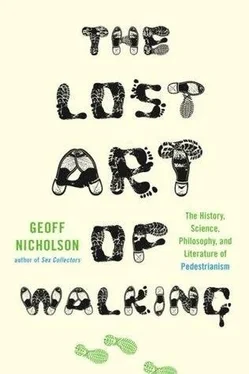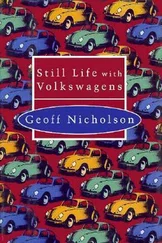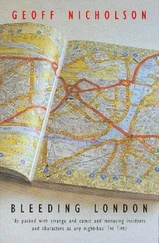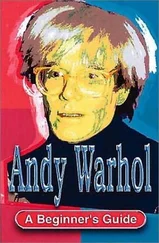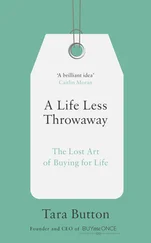Rain was sluicing down, hard as ever, but some of us, though by no means all, felt a duty to get out of the van and set foot on the lot. But none of us walked very far. We huddled under umbrellas, walked maybe a hundred yards from one corner of the lot to another, making the kind of conversation you might make on a tour of parking lots with people you didn’t know.
Then we all returned to the van and drove a very long way back west to see two other lots, one private rather than municipal, and one that was no longer a parking lot at all but was now ‘developed’ into the construction site for a theater designed by Frank Gehry. Nobody left the van at these sites — in fact the van didn’t even stop. As a professed walking tour it was a bust, and we were running late because of the traffic. By now we were a van full of restless, fidgety, full-bladdered tourists.
As we drove back to the art gallery, we lost the traffic and eventually passed through an amazing landscape of gorgeous industrial ruin. I had, and still have, only a sketchy idea of exactly where we were, somewhere near the water and in sight of the Williamsburg Bridge, an area of big, blank, formidable buildings interspersed with empty and ruined lots. There was nobody visible on the streets, certainly nobody walking, and you couldn’t have said there was any activity as such, and yet there was evidence of inscrutable things going on: anonymous trucks parked in front of loading bays, Dumpsters full of intriguing waste, barred and bolted doors and windows suggesting something precious or forbidden on the other side. I’d have been happy to walk around there on my own, and the next day I tried.
♦
The rain had finally stopped by then and I returned to Conflux, this time for a lecture by Denis Wood called ‘Lynch Debord! About Two Psychogeographies’, but I gave myself a couple of hours to take a walk before it started. Denis Wood is the author of a fine and light-footed book called The Power of Maps , which discusses the ways in which maps serve all sorts of purposes, very few of them having much to do with getting from A to B. Every map, he says, is made in somebody’s interest, and that interest is very unlikely to coincide with yours. I was hoping he’d say a few droll and irreverent things about Debord and psychogeography.
In truth I never got back to the exact streets we’d driven through the previous day, and I told myself it didn’t matter much. A walk was still a walk even if it didn’t take you exactly where you wanted it to. The area I found myself walking in wasn’t quite as rough or blighted as the one I’d seen through the van windows, but it was rough and blighted nevertheless. And at one moment I found myself under the roaring expressway, quite alone, standing on the forecourt of a garage next to a wrecked, rusted, and very beautiful 1950 sCadillac, which I think always gives class to a neighborhood.
But the best thing I saw, by far, was a huge factory built of red brick, a manufacturer of rubber goods, with a sign outside that said ‘If it’s made of Rubber we have it’. This was good in itself, but then I saw the name of the company (and I would still have some trouble believing it if I hadn’t taken a photograph): it was called the Auster Rubber Co. Inc. I walked all the way around the block that contained it, aware that I was tracing a rectangle that couldn’t seriously be mistaken for any letter, however misshapen.
♦
The Conflux lectures were being held in the back room of a nearby bar, the Lucky Cat. I got there five minutes before the Denis Wood lecture was due to start and I just about managed to get in the door. The crowd was spilling out of the back room into the front. There was standing room only and not much of that, and although I could see someone far away in the back, standing beside a screen and talking, I couldn’t hear anything he said.
This lecturer, it turned out, wasn’t Denis Wood, but the guy delivering the preceding lecture. There was no sign that this event was about to end, and even when it did, it seemed unlikely that the crowd would clear out and free up any seats. Denis Wood was going to be a hot ticket — if you were in possession of a chair down at the front you weren’t going to give it up.
The Lucky Cat was as hot, humid, and packed as a New York subway platform in highest summer. Sweat dripped off me and off everyone else. There was a dense, cloying smell of fried food and ketchup in the air. Maybe if I could have got to the bar and bought myself a drink it would have been different, but there was no way I could get through. I thought I might fall down or throw up. Suddenly I realized there was no way in the world I could bear to be in that space for another second, much less to stand there for the amount of time it would take to watch someone deliver a lecture on Debord and psychogeography.
I staggered out to the street. The evening was a warm one, but compared to the bar it offered a blast of cool, bracing air. I stood for a minute or two watching as more people arrived for the lecture — at first I thought I should join them, go back in, and tough it out. Then I thought, no, I don’t have to do that. I don’t have to do that at all. There was no duty, no obligation, nobody checking up on me. I was perfectly free to miss the lecture, to abandon my plan, to walk away — and that’s exactly what I did.
And as I went, I realized that walking away is one of life’s greatest pleasures, whether it’s walking away from a bad job, a bad relationship, a bad educational course, or a bad psychogeography festival. There was an extraordinary sunset over Williamsburg that night. The clouds looked like orange lizard skin and there were people on the street photographing it. The sky was putting on a show to celebrate my decision. I felt fantastic: I’d escaped. I was giddy with relief.
I had no complaints with anyone at Conflux. They were what they were. They did what they did. My needs and expectations weren’t their responsibility. I blamed myself. I was too cynical, too unhip, too much of a sourpuss, a loner, a solitary walker. And perhaps it’s absurd to call yourself a loner and a solitary walker when your chief walking pleasure involves exploring the streets of major metropolitan cities, but that was how I felt about New York, that it was a city crammed with solitary walkers, just like me. I didn’t need a guide or a map. I’d find my own damned way of walking this city. I would find my own version of a ‘constrained walk’.
♦
By then, it seemed to me that all walks are constrained walks one way or another. They’re inevitably constrained by time, by our imagination, by our physical limitations, and by the special character of the terrain we’re walking. One way to deal with the whole notion of constraint is simply to walk down every street in a given area or zone. This is certainly programmatic, but it does create a kind of pedestrian democracy, and makes all streets, all routes, equal. It also certainly avoids all the unities of ambiance.
The annals of pedestrianism are littered with people who have walked down every street of major cities. The queen is Phyllis Pearsall, the creator of the London A-Z . Starting in 1935, she walked 3,000 miles, mapping 23,000 streets, and working (though not necessarily walking) for eighteen hours a day. As far as I’m aware, nobody has attempted the same thing in the five boroughs of New York, but I know of three people who have systematically walked down every street in Manhattan, and there are surely more.
Thomas J. Keane, a naval officer, did it in the early fifties, and according to the New York Times , finished on December 15, 1954. Caleb Smith, a librarian at Columbia University, did it between 2002 and 2004, and on his website says he ‘walked over 700 miles’, which is very different from the mileage claimed by another Manhattan completist, Joseph D. Terwilliger, also connected to Columbia University, as an associate professor of neuroscience. He claims to have covered 1,279 miles, and he is certainly willing to enter into a debate about what constitutes a street, and indeed what constitutes Manhattan. He first did it in 2002, but it took him the whole year. And then he did it again in eighty days, between October 28, 2004, and January 14, 2005.
Читать дальше
